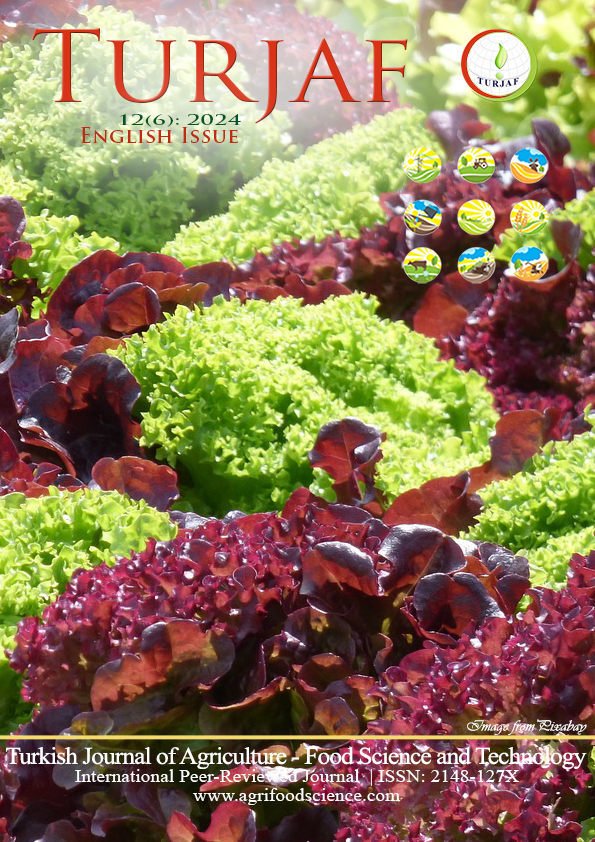Sustainable Energy Practices in Cabbage Production in Niğde Province of Türkiye
DOI:
https://doi.org/10.24925/turjaf.v12i6.893-898.6660Keywords:
farm inputs, output/input rate, Input-Output analysisAbstract
Examining the inputs to agricultural production and analyzing their energy implications is a crucial method for assessing environmental challenges and promoting sustainability. The agricultural industry utilizes energy in diverse ways, both directly and indirectly, encompassing pesticides, electricity, fertilizers, farm equipment, irrigation systems, fuel, and human labor. This research focused on assessing the agricultural inputs utilized in cabbage cultivation within one of the most cabbage cultivated area in Türkiye, gathering data on these inputs, and identifying the energy efficiency associated with this production process. In the study, information on the overall energy inputs was gathered from numerous white cabbage producers in the Niğde province using the face-to-face survey method, a quantitative research approach. According to the results of the research, the total energy input equivalent in cabbage production was determined as 4407.87 MJ da-1 and the total output value was determined as 6348.60 MJ da-1. The energy productivity was determined as 1.20 and the energy balance as 1940.73 MJ da-1. According to the findings, with 33.4% of diesel oil, 23.81% of fertilizer, and 23.06% of machinery make up the majority of this production's inputs. Also, 89.19% of the total energy inputs in cabbage production determined as non-renewable and 10.79% of them as renewable energy inputs. In conclusion, the inputs are efficiently utilized in cabbage production within the Niğde province of Türkiye.
References
Burnett, M. (1982). Energy analysis of three agro-eco systems. In Paper presented at second International Conference on Basic Techniques in Ecological Farming held during (pp. 1-5).
Esengun, K., Erdal, G., Gündüz, O., & Erdal, H. (2007). An economic analysis and energy use in stake-tomato production in Tokat province of Turkey. Renewable energy, 32(11), 1873-1881.
Gorur, A., Dogan, S., Caliskan, M, E., Unal, E. and Turkmen, H. S. (2016). Nigde İl Gelişme Planı (NİGEP). http://www.nigde.gov.tr/kurumlar/nigde.gov.tr/HaberResimler/OCAK%202017/nigep1.pdf
Gündogmus, E., & Bayramoglu, Z. (2006). Energy input use on organic farming: a comparative analysis on organic versus conventional farms in Turkey. Journal of Agronomy, 5 (1), 16-22.
Helsel, Z. R. (1992). Energy and alternatives for fertilizer and pesticide use. Energy in farm production, 6, 177-201.
Mandal, K. G., Saha, K. P., Ghosh, P. K., Hati, K. M., & Bandyopadhyay, K. K. (2002). Bioenergy and economic analysis of soybean-based crop production systems in central India. Biomass and bioenergy, 23(5), 337-345.
Mihov, M., Antonova, G., & Mihov, K. (2013). Energy assessment of new broccoli variety. Bulgarian Journal of Agricultural Science, 19(5), 1056-1060.
Mihov, M., Antonova, G., Masheva, S., & Yankova, V. (2012). Energy assessment of conventional and organic production of head cabbage. Bulgarian Journal of Agricultural Science, 18(3), 320-324.
Mittal, J. P. (1988). Research manual on energy requirements in agricultural sector. All India Co-ordinated Research... Agricultural Sector. New Delhi: ICAR. p.20 –3.
Ozkan, B., Akcaoz, H., & Fert, C. (2004a). Energy input–output analysis in Turkish agriculture. Renewable energy, 29(1), 39-51.
Ozkan, B., Akcaoz, H., & Karadeniz, F. (2004b). Energy requirement and economic analysis of citrus production in Turkey. Energy Conversion and Management, 45(11-12), 1821-1830.
Ozkan, B., Kurklu, A., & Akcaoz, H. (2004c). An input–output energy analysis in greenhouse vegetable production: a case study for Antalya region of Turkey. Biomass and Bioenergy, 26(1), 89-95.
Risoud, B. (2000, May). Energy efficiency of various French farming systems: questions to sustainability. In International Conference Sustainable energy: new challenges for agriculture and implications for land use (pp. 18-20). Wageningen: Wageningen University..
Saglam, C. and Cetin, N. (2018). Organik ve Geleneksel Bahçe Tarımında Enerji Kullanım Etkinliğinin Belirlenmesi. Bahçe, 47 (Special issue 2) 84–90.
Singh, H., Mishra, D., & Nahar, N. M. (2002). Energy use pattern in production agriculture of a typical village in arid zone, India––part I. Energy conversion and management, 43(16), 2275-2286.
Singh, M. K., Pal, S. K., Thakur, R., & Verma, U. N. (1997). Energy input-output relationship of cropping systems. The Indian Journal of Agricultural Sciences, 67(6).
Swanton, C. J., Murphy, S. D., Hume, D. J., & Clements, D. R. (1996). Recent improvements in the energy efficiency of agriculture: case studies from Ontario, Canada. Agricultural Systems, 52(4), 399-418.
TÜİK, (2022). Turkish Statistical Institute. https://www.tuik.gov.tr/, (Access date: 7.12.2023)
Yaldız, O., Öztürk, H. H., Zeren, Y., & Bașçetinçelik, A. (1993). Energy usage in production of field crops in Turkey. 5th International Congress on Mechanization and Energy Use in Agriculture, 527-536. https://www.cabidigitallibrary.org/doi/full/10.5555/19942400018
Yilmaz, I., Akcaoz, H., & Ozkan, B. (2005). An analysis of energy use and input costs for cotton production in Turkey. Renewable Energy, 30(2), 145-155.
Downloads
Published
How to Cite
Issue
Section
License
This work is licensed under a Creative Commons Attribution-NonCommercial 4.0 International License.









